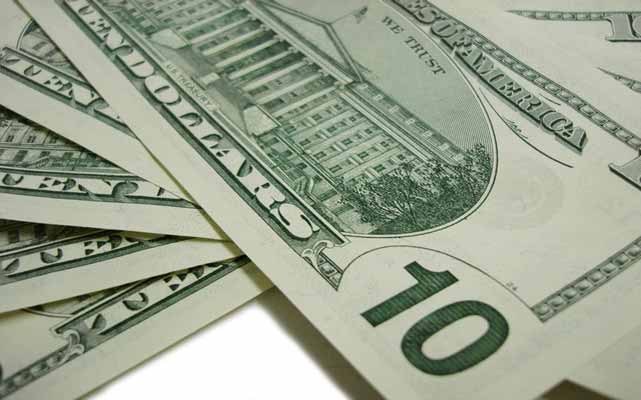Pound to Dollar Forecast: Best Buying Below 1.30, 2025 Target Still 1.36
April 6, 2025 - Written by Frank Davies

The Pound-to-Dollar exchange rate (GBP/USD) briefly hit 6-month highs at 1.32 after President Trump announced major tariffs on US imports before sliding to just below 1.29 amid market turmoil and a crash in equities.
There is a huge element of uncertainty and markets overall reacted with the sharpest moves since the coronavirus pandemic.
There will inevitably be major investment bank forecast changes over the next few weeks with markets, central banks and governments all scrambling to respond.
UBS sees a changed profile but, for now, is still forecasting that GBP/USD will strengthen to 1.36 at the end of 2025.
It expects a further near-term setback, but is more confident that there will be buying below 1.30.
Deutsche Bank expects the dollar will weaken further amid a structural exodus from the US currency.
HSBC, however, is not convinced that dollar selling will continue given notable damage to the global economy.

President Trump’s tariff announcement dominated during the week.
Although the event had been strongly flagged in advance, the overall announcement still triggered notable surprise and very sharp reactions in markets.
According to Nomura; “President Trump’s reciprocal tariff announcements were more severe than our expectations.”
The US Administration announced a baseline 10% tariff on all imports into the US which came into effect on April 5th.
Many major countries, however, were given higher tariffs. Although labelled as reciprocal, the extra levies simply punished countries running trade surpluses with the US.
The EU was set at 20%, Japan at 24% and China at 34%. These are scheduled to come into effect on April 9th while UK avoided further punishment.
There will inevitably be disruption for the US and global economies.

JP Morgan commented on the US outlook “The effect of this tax hike is likely to be magnified — through retaliation, a slide in U.S. business sentiment, and supply chain disruptions.”
Morgan Stanley sees a 60% chance of US recession this year.
Fears that the trade war will escalate triggered a slump in equities with the S&P 500 index sliding 6.0% on Friday after a 4.8% decline on Thursday while the FTSE 100 index slid to 2025 lows.
Fawad Razaqzada, market analyst at City Index and FOREX.com commented; “So far, risk appetite has been literally non-existent.”
Although there could be deals to ease tariffs he added; “it looks like the trade war is only intensifying with China – and soon to follow others – coming back with counter measures.”
Actions by central banks will also be crucial for markets.
Fed Chair Powell noted the potential for weaker growth and higher inflation, but stated that it was too early to draw conclusions for monetary policy and interest rates, refusing to contemplate any kind of emergency action.
Markets, however, consider that a Fed rate cut by midyear is inevitable and demands for rapid action will increase sharply if market turmoil intensifies.
According to Nomura; “Increased downside risks to growth and a front-loaded inflation shock should allow cuts to resume sooner than we had expected.”
UBS noted the potential for high volatility; “We believe the US economy will likely suffer more than other regions, potentially prompting additional easing by the Federal Reserve and further weakening the dollar. However, upcoming tariff renegotiations could provide some relief, and potential discussions around tax cuts might support the USD in the coming weeks and months.”
According to HSBC; “These tariffs will have material adverse impacts on other economies, more so if we see retaliation. FX will need to respond to lower growth expectations for China, the Eurozone, and the UK among others. Markets need to digest a global economic slowdown, not just a US one. When this reality sinks in, the US will likely regain its relative allure in this potential race to the bottom for economic activity.
ANZ added; “global growth shock from tariffs may reassert USD strength.”
UBS noted that the dollar usually strengthens during periods of markets stress, but there has been a reversal since the 2024 election with the dollar weakening when equity markets slide.
According to Deutsche Bank this is a function of a wider loss of dollar confidence; “The safe haven properties of the dollar are being eroded. Beyond that, developments since the start of the year make us worried about a broader undermining of confidence in the US economic outlook.”
There have been substantial capital flows into the US over the past few years
Deutsche added; “Our overall message is that there is a risk that major shift in capital flow allocations take over from currency fundamentals and that FX moves become disorderly.”
STORY LINK Pound to Dollar Forecast: Best Buying Below 1.30, 2025 Target Still 1.36

The Pound-to-Dollar exchange rate (GBP/USD) briefly hit 6-month highs at 1.32 after President Trump announced major tariffs on US imports before sliding to just below 1.29 amid market turmoil and a crash in equities.
There is a huge element of uncertainty and markets overall reacted with the sharpest moves since the coronavirus pandemic.
There will inevitably be major investment bank forecast changes over the next few weeks with markets, central banks and governments all scrambling to respond.
UBS sees a changed profile but, for now, is still forecasting that GBP/USD will strengthen to 1.36 at the end of 2025.
It expects a further near-term setback, but is more confident that there will be buying below 1.30.
Deutsche Bank expects the dollar will weaken further amid a structural exodus from the US currency.
HSBC, however, is not convinced that dollar selling will continue given notable damage to the global economy.

President Trump’s tariff announcement dominated during the week.
Although the event had been strongly flagged in advance, the overall announcement still triggered notable surprise and very sharp reactions in markets.
According to Nomura; “President Trump’s reciprocal tariff announcements were more severe than our expectations.”
The US Administration announced a baseline 10% tariff on all imports into the US which came into effect on April 5th.
Many major countries, however, were given higher tariffs. Although labelled as reciprocal, the extra levies simply punished countries running trade surpluses with the US.
The EU was set at 20%, Japan at 24% and China at 34%. These are scheduled to come into effect on April 9th while UK avoided further punishment.
There will inevitably be disruption for the US and global economies.

JP Morgan commented on the US outlook “The effect of this tax hike is likely to be magnified — through retaliation, a slide in U.S. business sentiment, and supply chain disruptions.”
Morgan Stanley sees a 60% chance of US recession this year.
Fears that the trade war will escalate triggered a slump in equities with the S&P 500 index sliding 6.0% on Friday after a 4.8% decline on Thursday while the FTSE 100 index slid to 2025 lows.
Fawad Razaqzada, market analyst at City Index and FOREX.com commented; “So far, risk appetite has been literally non-existent.”
Although there could be deals to ease tariffs he added; “it looks like the trade war is only intensifying with China – and soon to follow others – coming back with counter measures.”
Actions by central banks will also be crucial for markets.
Fed Chair Powell noted the potential for weaker growth and higher inflation, but stated that it was too early to draw conclusions for monetary policy and interest rates, refusing to contemplate any kind of emergency action.
Markets, however, consider that a Fed rate cut by midyear is inevitable and demands for rapid action will increase sharply if market turmoil intensifies.
According to Nomura; “Increased downside risks to growth and a front-loaded inflation shock should allow cuts to resume sooner than we had expected.”
UBS noted the potential for high volatility; “We believe the US economy will likely suffer more than other regions, potentially prompting additional easing by the Federal Reserve and further weakening the dollar. However, upcoming tariff renegotiations could provide some relief, and potential discussions around tax cuts might support the USD in the coming weeks and months.”
According to HSBC; “These tariffs will have material adverse impacts on other economies, more so if we see retaliation. FX will need to respond to lower growth expectations for China, the Eurozone, and the UK among others. Markets need to digest a global economic slowdown, not just a US one. When this reality sinks in, the US will likely regain its relative allure in this potential race to the bottom for economic activity.
ANZ added; “global growth shock from tariffs may reassert USD strength.”
UBS noted that the dollar usually strengthens during periods of markets stress, but there has been a reversal since the 2024 election with the dollar weakening when equity markets slide.
According to Deutsche Bank this is a function of a wider loss of dollar confidence; “The safe haven properties of the dollar are being eroded. Beyond that, developments since the start of the year make us worried about a broader undermining of confidence in the US economic outlook.”
There have been substantial capital flows into the US over the past few years
Deutsche added; “Our overall message is that there is a risk that major shift in capital flow allocations take over from currency fundamentals and that FX moves become disorderly.”
International Money Transfer? Ask our resident FX expert a money transfer question or try John's new, free, no-obligation personal service! ,where he helps every step of the way, ensuring you get the best exchange rates on your currency requirements.
Comments are currrently disabled
Related Stories:
- Euro to Dollar Forecast: EUR Uptrend in Tact, 1.15 Resistance - April 27, 2025
- Pound to Dollar Forecast: RSI Firmly Bullish, Resistance Closer to 1.34 - April 27, 2025
- Pound to Euro Week Ahead Forecast: Overvalued Sterling "Vulnerable to Correction" - April 27, 2025
- Euro and Pound Sterling Forecast to Surge Against Dollar say Scotiabank - April 25, 2025
- Pound Sterling to Euro Forecast: Dollar Slide Could Enable Strong GBP Gains - April 25, 2025
- Pound Sterling to Euro Forecast: "GBPEUR Underperformance Likely" - April 24, 2025
- GBP/EUR Forecast: 3-Month Pound Sterling Forecast of 1.15 - April 23, 2025
- GBP/USD Forecast: Pound Sterling Rally Stalls as "Momentum is Overbought" - April 22, 2025
- Euro to Dollar Forecast: Further EUR Upside to Upper 1.16s? - April 20, 2025
Latest News:
- Euro to Dollar Forecast: EUR Uptrend in Tact, 1.15 Resistance - April 27, 2025
- Pound to Dollar Forecast: RSI Firmly Bullish, Resistance Closer to 1.34 - April 27, 2025
- Pound to Euro Week Ahead Forecast: Overvalued Sterling "Vulnerable to Correction" - April 27, 2025
- Euro to Dollar Forecast: US Equities "Could Drag EUR/USD to 1.1250" - April 25, 2025
- Pound to Dollar FX Forecast: GBPUSD "Trend Remains Bullish" - April 25, 2025
- Euro and Pound Sterling Forecast to Surge Against Dollar say Scotiabank - April 25, 2025
- Pound Sterling to Euro Forecast: Dollar Slide Could Enable Strong GBP Gains - April 25, 2025
- Pound to Dollar Rate Higher as Renewed Tariff Fears Spook USD Buyers - April 25, 2025
- Pound to Euro Rate Dips as EUR Bolstered by Upbeat Data, USD Weakness - April 25, 2025
- GBP/USD Forecast: Pound Sterling Bullish, Next Resistance at 1.34 - April 24, 2025








